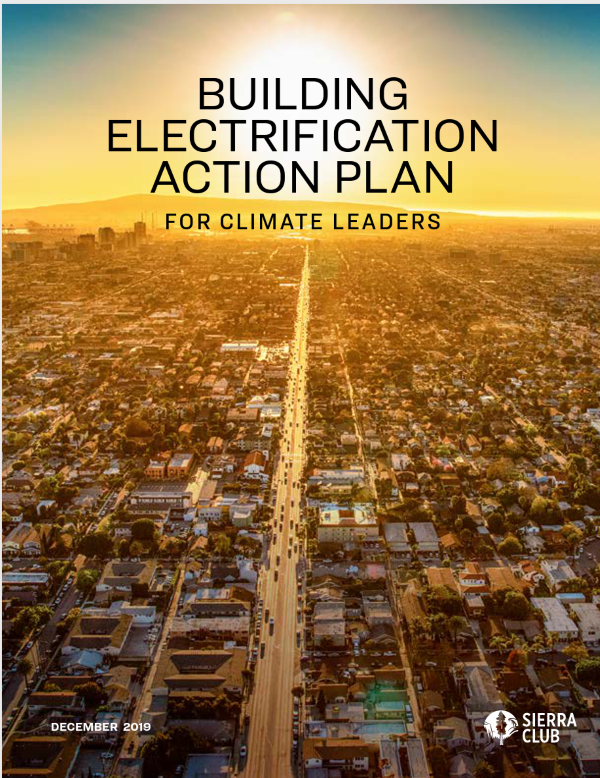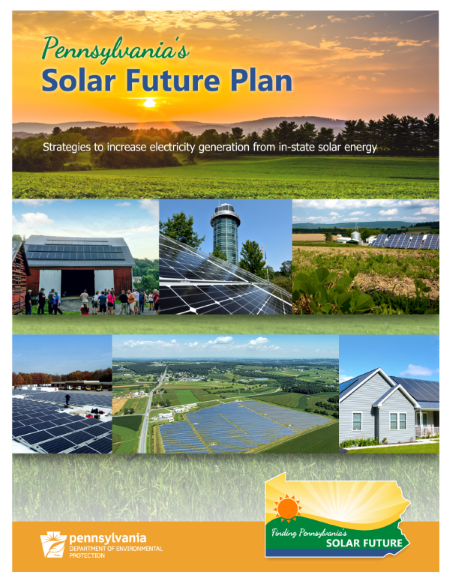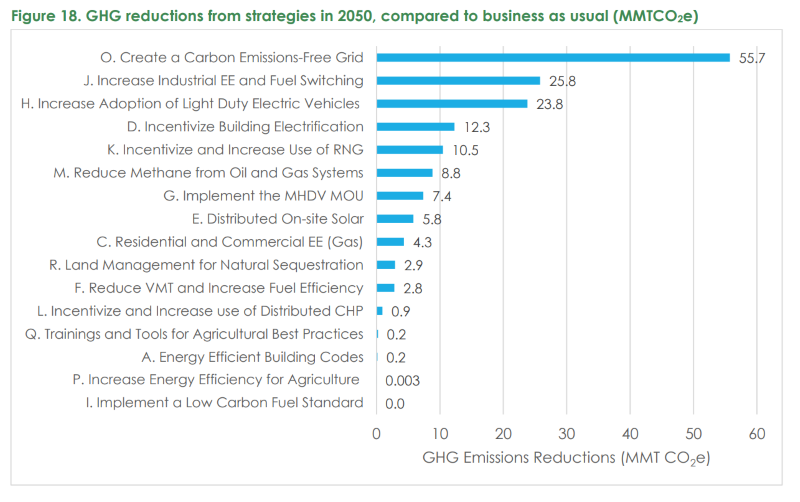Review of the 2021 PA Climate Action Plan: Strategies Related to Clean Energy
By Alison Moyer and the Sierra Club PA Clean Energy Team
The 2021 Pennsylvania Climate Action Plan lays out five main clean energy-related strategies to reduce greenhouse gas (GHG) emissions in the Commonwealth. Ultimately, these goals aim to meet Executive Order 2019-01 that sets targets of a 26% GHG reduction by 2025 from 2005 levels and an 80% reduction by 2050. Those five strategies are: adopt and enforce the most recent building codes for energy efficiency; increase utilization of distributed combined heat and power (CHP) through microgrids; install more on-site distributed solar energy in commercial and residential sectors; incentivize building electrification (e.g. heating); and develop a carbon emissions-free grid.
According to the timeline under the Plan, as displayed here, the first three strategies will be implemented within five years while the fourth strategy will be implemented in ten years. These four strategies together will help achieve the fifth strategy of a carbon-free grid which will take more than ten years to be fully executed.

image from PA Climate Action Plan 2021 Booklet pg 8
Developing a Carbon Emissions-Free Grid
The transition to a carbon-free grid will rely heavily on replacing fossil fuels with renewable energy sources, such as solar. Figure 19 in the plan shows a promising forecast that by 2050, the current 6% of total electricity generation from renewables will rise to 58%. The Alternative Energy Portfolio Standard (AEPS) established in 2004 has supported this forecast by setting thresholds for the amount of electricity that must come from renewable sources by the state’s electric distribution companies.
The mix of energy sources will need to be 100% non-carbon by 2050. The plan specifies some sources and enabling technologies that will position the Commonwealth to meet this percentage requirement. Namely, the solar carve-out of total renewable energy will increase to 10% by 2030 which is in line with the Pennsylvania Solar Future Plan; this increase will also raise the value of solar renewable energy credits (SRECs), but legislation must be enacted to nurture this growing solar market.

image from 2021 PA Climate Action Plan pg 59
While the Sierra Club supports the 10% solar carve-out increase in the PA Solar Future Plan, we do not agree with the CAP’s strategy of maintaining current nuclear levels for the grid. Figure 19 shows that nuclear will remain the second main source for electricity generation in 2050; it is currently second only to natural gas. Keeping current nuclear energy levels means maintaining existing nuclear power plants with no retirements. Subsidizing nuclear power plants diverts funds from expanding renewable energy infrastructure at a large scale. Thus, the Sierra Club instead recommends that nuclear power plants should be retired when their permits expire (all before 2045) and be replaced with renewable energy sources.
Incentivizing Building Electrification (e.g. heating)
A large part of decarbonizing the grid will come from increasing building electrification, especially heat. Electricity generation currently emits the greatest amount of GHG—30% of total emissions—in Pennsylvania. Nonetheless, increasing electrification now (before increasing renewable energy significantly) will still produce climate benefits. The CAP, as well as the Sierra Club, advocate for converting homes heated by gas to electric heat pumps. Along with converting buildings to electric, new construction should be fully electric from the start as this is much more cost effective than retrofitting them later. According to a 2020 Sierra Club article, “New Analysis: Heat Pumps Slow Climate Change in Every Corner of the Country,” the average home that switches from gas to heat pumps will reduce its emissions by 45% over the next 10 years.
 The plan does not mention many incentive approaches to accelerate the switch to electric in buildings. It mentions a rebate program to encourage electrification solutions in Maine where buildings without air conditioning could receive heat pumps and gain a portion of the heating market share. The initial goal would be to grow the market share and demonstrate how heat pump technology is effective, reliable, and sustainable.
The plan does not mention many incentive approaches to accelerate the switch to electric in buildings. It mentions a rebate program to encourage electrification solutions in Maine where buildings without air conditioning could receive heat pumps and gain a portion of the heating market share. The initial goal would be to grow the market share and demonstrate how heat pump technology is effective, reliable, and sustainable.
In terms of environmental equity, the CAP states that low- and moderate-income customers must participate in electrifying their homes, but offers no methods to do so. In its Building Electrification Action Plan for Climate Leaders, the Sierra Club recommends that local policymakers lower bills for residents who switch to electric heating (this can be in the form of incentives or rate reform). Furthermore, programs should be put in place that electrify the homes of low-income residents at nearly zero cost. It must be noted that during the initial years of electrifying heat in the industrial sector, the reduction in carbon emissions will be partially offset by the electricity generation emissions. To overcome this, the grid must continue to switch to cleaner generating sources.
Installing More On-site Distributed Solar Energy
Distributed on-site solar plays a critical role in decarbonising the grid. The CAP states that the Commonwealth has already encouraged on-site solar installations through the use of incentives and policies. For instance, the PA Sunshine Solar Rebate program gives rebates to installers of solar projects. The AEPS also provides funding to solar installations, which have continued to increase due to the decline in cost of these projects. The Commonwealth began an initiative in 2021 to obtain nearly 50% of state agencies’ power from seven new solar energy arrays that will be constructed by 2023. The CAP calls for a strengthened AEPS that will inspire additional solar projects through a market-based program. Thus, policies that increase the value of SRECs are of utmost importance to make such a market more robust. The solar projects can be constructed in buffer zones or abandoned areas like fields and warehouses.
The plan does not mention specific statewide projects, such as for of Community Solar, for which a bill is before the PA legislature. It would give businesses and residents the opportunity to purchase a share of an offsite solar project connected to their respective electric distribution company’s grid. Every month, the purchaser of the share would receive credit on their electricity bill for the power produced. The PA Solar Future Plan states that to generate 10% of total electricity in Pennsylvania, grid-scale solar will only need 124 sq. miles (less than three-tenths of 1% of the state’s total land area of 46,055 square miles). The Sierra Club strongly approves of Community Solar as it allows people and businesses without roofs or land suitable for solar installation to purchase shares of solar offsite and grow the market.
In addition to increasing solar projects, the CAP suggests that grid-scale solar should be paired with battery storage technology. This system together will reduce strain on the grid and can be utilized as a backup energy source during grid blackouts. Specifically, the plan aims to incorporate nearly 47 GW of four-hour battery storage capacity by 2050; this serves as a key peak load management strategy and practice to boost grid resiliency.
Demand-and-response and time-of-use rates are other load management techniques. The latter would provide economic incentives for customers to use electricity in ways that reduce peak loads on the grid. If such strategies are not used and there are large load peaks, costs will increase (due to decrease in efficiency) and stable grid reliability will decrease. To keep the grid in balance, input (generation) must equal output (electricity use) at all times. At times of peak energy demand, distributed energy resources (DER) and small-scale battery storage may also be required to keep the grid in balance. To make the grid safe and resilient, it must be paired with batteries, microgrids, and smart technology to quickly locate outages.

image from PA's Solar Future Plan
Increasing Utilization of Distributed Combined Heat and Power (CHP)
Combined heat and power (CHP) microgrid systems can be manufactured to function during grid interruptions. These systems, when properly configured, are approximately 50% more efficient than sourcing separate heat and grid power. The CAP emphasizes that CHP should be used at “critical facilities” like hospitals and some parts of the industrial sector. These facilities are able to run CHP systems continuously (as to reduce or even eliminate energy waste). While the Sierra Club does not totally support CHP systems as they tend to rely on fracked gas for fuel, we support these systems in capturing and using waste heat in cases where full electrification of a building or process is not viable. They can provide steam and other cooling services in addition to heat and electricity; thus, efficient CHP can provide a great value from a single energy source.
Initiating the Most Recent Building Codes for Energy Efficiency
Instituting the most up-to-date building codes would lead to energy efficiency and savings on consumers’ energy bills by reducing the amount of electricity and gas required for the respective energy demand. Currently, the average home in the Commonwealth is 65 years old, around 1,900 sq. feet, and approximately 61% less efficient than homes built to the 2009 IECC code. To add context, the International Code Council (ICC) updates its international building codes every three years (2021 being the latest). Pennsylvania largely uses the 2015 code with the exception of Philadelphia using the 2018 code for commercial buildings. The 2015 code alone is up to 25% more energy efficient than the 2009 code. While the CAP does not specify which “most up-to-date” code it uses in this estimation, it projects a $13.97 billion net present value of investing in the initiation of the most recent building codes.
Code inspectors would have to be trained in these codes. Particularly, however, the CAP encourages the creation and adoption of a single “stretch” code as such consistency would make it easier for developers to use energy-saving construction practices. A stretch code is more aggressive than a base code in transitioning communities to use more energy efficient codes. The CAP does not detail what a “Pennsylvania-specific” stretch would look like, but it mentions that existing NetZero or Zero codes in other states could serve as frameworks. These codes would denote that the buildings are all electric and either include renewable energy onsite for some or all of the building energy needs; net zero means that the consumer could purchase clean energy to supplement whatever could be produced onsite. To incentivize more efficient new construction, local municipalities could offer expedited building permits.
Can Pennsylvania meet the CAP’s GHG reduction target of 80% by 2050?
In total, the strategies proposed in Table ES-1 do add up to meeting the end target of 2050 and then some. While a carbon-free grid will only gradually reduce GHG in the near and mid-terms, by 2050 it could reduce GHG emissions by the greatest amount—55.7 MMTCO2e compared to the business-as-usual BAU (Figure 18 in the CAP). Under the BAU scenario (no further reduction strategies are implemented), we nearly hit the 2025 target but do not come close to meeting the 2050. Thus, it is imperative that the five clean energy-related strategies are implemented in the timeline proposed in this plan.
To move forward with these goals and gain funding for the infrastructure needed to make them happen, we must continue to educate Pennsylvanians about the social, economic, and health benefits that come from a transition to clean energy. In terms of job creation alone, a 2021 study estimates that the Commonwealth can make 243,000 new jobs each year from 2021 through clean energy projects and investments. For funding these undertakings in the near future, the Sierra Club encourages everyone to support Pennsylvania officially joining the carbon cap-and-trade Regional Greenhouse Gas Initiative (RGGI) this year (2022). To find more information about RGGI, you can view this quick read on the Sierra Club website.

image from 2021 PA Climate Action Plan pg 58
This blog was included as part of the February 2022 Sylvanian newsletter. Please click here to check out more articles from this edition!